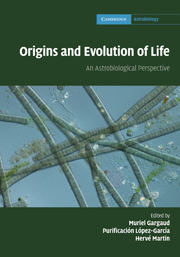Book contents
- Frontmatter
- Contents
- List of contributors
- Foreword
- Preface
- Part I What is life?
- Part II Astronomical and geophysical context of the emergence of life
- Part III The role of water in the emergence of life
- Part IV From non-living systems to life
- 16 Energetic constraints on prebiotic pathways: application to the emergence of translation
- 17 Comparative genomics and early cell evolution
- 18 Origin and evolution of metabolisms
- Part V Mechanisms for life evolution
- Part VI Life in extreme conditions
- Part VII Traces of life and biosignatures
- Part VIII Life elsewhere?
- Index
17 - Comparative genomics and early cell evolution
from Part IV - From non-living systems to life
Published online by Cambridge University Press: 04 February 2011
- Frontmatter
- Contents
- List of contributors
- Foreword
- Preface
- Part I What is life?
- Part II Astronomical and geophysical context of the emergence of life
- Part III The role of water in the emergence of life
- Part IV From non-living systems to life
- 16 Energetic constraints on prebiotic pathways: application to the emergence of translation
- 17 Comparative genomics and early cell evolution
- 18 Origin and evolution of metabolisms
- Part V Mechanisms for life evolution
- Part VI Life in extreme conditions
- Part VII Traces of life and biosignatures
- Part VIII Life elsewhere?
- Index
Summary
Introduction
The awareness that genes and genomes are extraordinarily rich historical documents from which a wealth of evolutionary information can be retrieved has widened the range of phylogenetic studies to previously unsuspected heights. The development of efficient sequencing techniques, which now allows the rapid sequencing of complete cellular genomes, combined with the simultaneous and independent blossoming of computer science, has led not only to an explosive growth of databases and new sophisticated tools for their exploitation, but also to the recognition that, in spite of many lateral gene-transfer (LGT) events, different macromolecules are uniquely suited as molecular chronometers in the construction of nearly universal phylogenies.
Cladistic analysis of rRNA sequences is acknowledged as a prime force in systematics and from its very inception had a major impact on our understanding of early cellular evolution. The comparison of small-subunit ribosomal-RNA (16/18S rRNA) sequences led to the construction of a trifurcated unrooted tree in which all known organisms can be grouped in one of three major monophyletic cell lineages, i.e. the domains Bacteria (Eubacteria), Archaea (Archaeabacteria) and Eukarya (Eukaryotes) (Woese et al., 1990), which are all derived from an ancestral form, known as the last common ancestor (LCA).
- Type
- Chapter
- Information
- Origins and Evolution of LifeAn Astrobiological Perspective, pp. 259 - 269Publisher: Cambridge University PressPrint publication year: 2011



